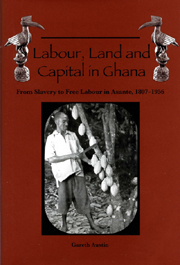Book contents
- Frontmatter
- Contents
- List of Illustrations
- List of Tables
- Preface
- Note on Names
- Maps
- Note on the Maps
- 1 Introduction
- Part I Context and Concepts
- 2 Theories and Debates: Some Tools for Thinking about the History of Property and Markets in Asante and Beyond
- 3 Asante, 1807–1956: The State, Output and Resources
- 4 The Changing Relationship Between Inputs and Output, 1807–1956
- Part II Social Relations of Production and Trade, 1807–1896: Absent and Imperfect Factor Markets
- Part III Slavery as Hobson's Choice: An Analysis of the Interaction of Markets and Coercion in Asante's Era of ‘Legitimate Commerce’, 1807–1896
- Part IV The Decline of Coercion in the Factor Markets of Colonial Asante: Cocoa and the Ending of Slavery, Pawnship and Corvée, 1896–c.1950
- Part V Social Relations of Production and Trade, 1908–1956: Towards Integrated Factor Markets?
- Part VI Freedom and Forest Rent, 1908–1956
- Abbreviations Used in the Notes
- Notes
- List of References
- Index
2 - Theories and Debates: Some Tools for Thinking about the History of Property and Markets in Asante and Beyond
from Part I - Context and Concepts
Published online by Cambridge University Press: 12 September 2012
- Frontmatter
- Contents
- List of Illustrations
- List of Tables
- Preface
- Note on Names
- Maps
- Note on the Maps
- 1 Introduction
- Part I Context and Concepts
- 2 Theories and Debates: Some Tools for Thinking about the History of Property and Markets in Asante and Beyond
- 3 Asante, 1807–1956: The State, Output and Resources
- 4 The Changing Relationship Between Inputs and Output, 1807–1956
- Part II Social Relations of Production and Trade, 1807–1896: Absent and Imperfect Factor Markets
- Part III Slavery as Hobson's Choice: An Analysis of the Interaction of Markets and Coercion in Asante's Era of ‘Legitimate Commerce’, 1807–1896
- Part IV The Decline of Coercion in the Factor Markets of Colonial Asante: Cocoa and the Ending of Slavery, Pawnship and Corvée, 1896–c.1950
- Part V Social Relations of Production and Trade, 1908–1956: Towards Integrated Factor Markets?
- Part VI Freedom and Forest Rent, 1908–1956
- Abbreviations Used in the Notes
- Notes
- List of References
- Index
Summary
The first chapter introduced the conceptual framework of this study, defining key terms and identifying general theoretical and historiographical reference-points. Some readers will be content to proceed directly to Chapter 3. Others, however, will find a brief elaboration of certain aspects of the conceptual framework necessary, either for an introductory (if necessarily compressed) exposition or to clarify definitions.
Two particular sets of ideas have fed the debate on the history of property and markets in factors of production in Africa and elsewhere. The general controversy about the dynamics of, and constraints upon, economic development in African history turns to a great extent on the extent and significance of the evolution of markets and private property rights in factors of production. This discussion is surveyed in Section A. The specific theory of institutional change offered by the rational-choice school is expanded upon in Section B: the induced innovation or evolutionary theory of property rights and, conversely, of rent-seeking. In line with the eclectic and open-ended approach to theory declared in Chapter 1, the emphasis in both sections is on setting up questions and hypotheses for the empirical investigation which follows.
Marxist, Dependency and Agrarian-Populist Perspectives on the Development of Capitalist Institutions in Africa
The mix of market and non-market relations in the social organization of production in Africa has stimulated controversy over how far market institutions have ‘emerged’ and proliferated; whether their spread is finished; whether they have raised and can promote economic efficiency and with what implications for equity; and how far their spread has been driven by external or internal forces.
- Type
- Chapter
- Information
- Labour, Land and Capital in GhanaFrom Slavery to Free Labour in Asante, 1807–1956, pp. 23 - 33Publisher: Boydell & BrewerPrint publication year: 2005

